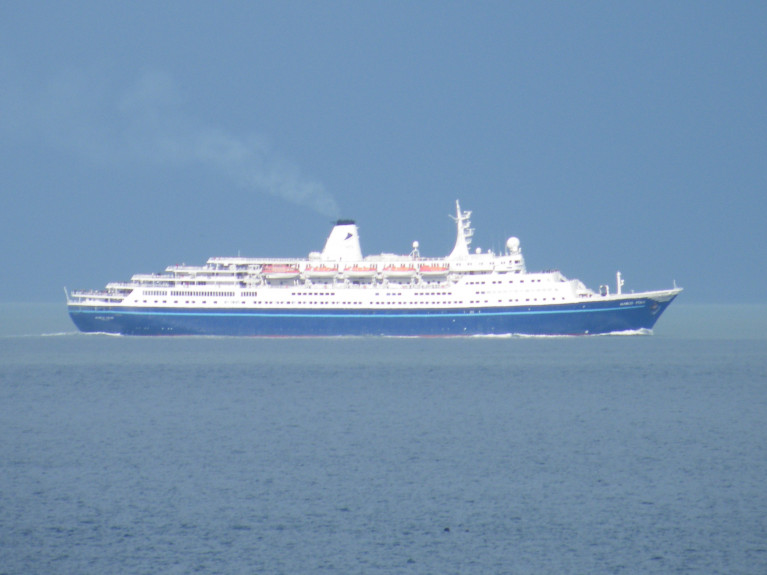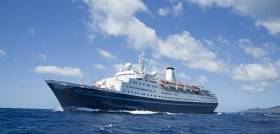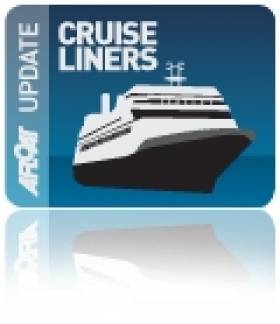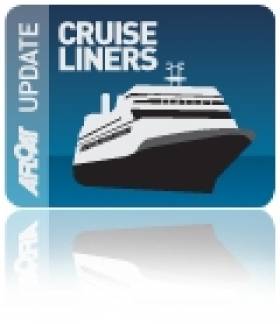Displaying items by tag: Marco Polo
Cruiseships of Collapsed CMV that Served Irish Cruisegoers 'Directly' - Head to the Shipbreakers
Three cruiseships, two of which served Irish holidaymakers on non-fly 'direct' cruises out of Dublin and Cork in the last decade, have this winter departed UK waters but to head to the shipbreakers, writes Jehan Ashmore.
All these developments originate from Cruise & Maritime Voyages (CMV) dramatic collapse last summer as the impact of Covid-19 adversely affected the global cruise industry. For a decade CMW had also offered British holidaymakers direct cruises from London (Tilbury) and among the regionals ports of Avonmouth (Bristol) incl. this cruisestory) Liverpool, Greenock, Glasgow and Hull as Afloat previously reported.
The Purfleet in Essex based operator, Cruise & Maritime Voyages went into administration and this would later led to auctions of the small to medium sized cruiseship fleet that were steadily added since 2010, the year the cruise company launched.
The first CMV cruiseship to go to a shipbreaker was Astor in November, sailing to Aliagra, Turkey, after a career that included visiting Irish waters.
The other two cruiseships were Marco Polo, that in January followed the same fate of Astor but to Indian shipbreakers and Magellan also repeated the same scenario. The pair headed to Alang, the location is famously known for its shipbreaking.
CMV and other operators are casualities of the pandemic, as are many older and or less efficient cruiseships since disposed, while noting the need to have ever 'greener' newbuilds.
Irish 'Direct' Cruises
The classic former 'liner' serving, Marco Polo of 800 cruisegoers and Magellan both operated in the Irish market. The latter larger 1,250 capacity cruiseship it should be added was a 'gamechanger' for CMV as in 2015 the ship launched their first worldwide cruise.
To reflect on their Irish career operations, Magellan was 'home' ported in Dublin with cruisegoers also embarking directly in Cork (Cobh). Among the cruise programme this involved the Norwegian fjords & Iceland, the Baltic Sea, Iberian Peninula, Canary Islands & Madiera and the Meditteranean Sea. Marco Polo also served Belfast with direct cruising though this was more limited compared to the Magellan's career out of Irish Ports.
As referred above overseas cruises were available from the UK too, where CMV built up a loyal fan base that was not shy of its independent status with those more established British traditional cruise brands. CMV operated cruises to Canada, Caribbean, South America, Mexican Riviera, Australia etc and with offices opened for markets in the US, Germany and more recently France.
Marco Polo and Magellan were part of a six-strong CMV fleet and mostly bore names of famous explorers down the centuries. Cabin accommodation decks were named after the oceans and seas, while passenger decks reflected famous explorers including polar related. In addition amenities such as the 'Scott's Bar' on the Marco Polo and the 'Shackleton' Conference Lounge of the Magellan.
Use of these famous polar names evoking the golden era of Antarctica expeditions was highlighted by Afloat's coverage of the Marine Institute's research vessel, RV Tom Crean (see update: on technology). The newbuild to be named after the renowned Co. Kerry man is under construction and is to join RV Celtic Explorer next year.
Marco Polo's 'Celtic Explorer' Cruise
It was in neighbouring Co. Cork where during CMV's inaugural season in 2010, Marco Polo made four cruises to Ireland among them the 'Celtic Explorer' cruise with an anchorage call off Glengariff.
The location was apt given the nearby open seas from where Marco Polo's history revealed that of a former trans-Atlantic liner. The East German 1965 built Alexandra Pushkin was one of five Russian Poet class ships that served during the Soviet era.
Another cruise by Marco Polo in the year before, was personally observed from the same scenic Irish shoreline and with much fondness as tenders were kept busy. At that stage the cruiseship's association with Transocean Tours went into adminstration, however Cruise & Maritime Services (CMS) agreed to take over the charter commitment with Global Cruise Lines.
Also that year to consolidate closer links with the Global Maritime Group (see below) this led to a new name, Cruise & Maritime Voyages in advance of CMV's debut season in 2010.
Marco Polo in more recent years also made several Festive Season Mini Cruises out of Avonmouth Docks (Port of Bristol) to Dublin and Cork with a single overnight stay. This to enable cruisegoers to take in tourist attractions and shopping in the capital and the southern city.
Soviet liner era
In 1966 the ship under the Black Sea Shipping Company reopened for the first time since 1949 a trans-Atlantic service. This involved a Leningrad (now St. Petersberg) - London (Tilbury) service including an onward 8 day ocean voyage to Quebec and Montreal in Canada. The ship along with its CMV years had a career spanning more than 50 years, and also become the final ship of the 'Poet' class to remain in service.
Prior to Marco Polo becoming CMV's first cruiseship, through Global Maritime Group's acquisition of Orient Lines cruiseship which was under the same name had operated in Asia. The cruiseship then sported a dark blue hull but adopted by CMV as a livery scheme that only up to December 2019 was applied to Magellan, during both of the ships refits at the Damen Group's dockyard in Amsterdam.
The traditional and elegant lines of Marco Polo saw the veteran vessel gain a loyal following with CMV and not just UK clientele, given the ship's traditional design, of intimate interiors, 'timber' decks, the tiered fore and aft 'sun' decks all presenting a pleasant external profile and somewhat like the QE2. The final transAtlantic liner of Cunard Line, made a farewell to Cork Harbour in 2008 and remains as a 'static' hotel ship in Dubai, a same role that was to await Marco Polo until plans changed dramatically with the ship scrapped.
Notably, Marco Polo was also one of the oldest remaining ocean-going cruiseships. By coincidence, an older fleetmate, Astoria, dating to 1948 but heavily rebuilt in the 1990's, remains with a fate that could potentially follow that of Marco Polo, given the former veteran vessels age.
The remaining two of the CMV fleet have also departed UK waters with the larger cruiseships alluded above, they are the flagship Columbus and relative newcomer Vasca de Gama sold at auction to Greek based Seajets. The Pireasus based operator also acquired a pair of Holland America Line cruiseships as Alfoat previously reported when awaiting their fate while at anchor of Cyprus last summer.
A further pair of secondhand cruiseships from P&O Australia were to join the CMV fleet as Afloat also reported, however with the operator's insolvency this was never to be.
Blue 'Hull' Former Classic Liner Continues to Cruise On Blue Waters and Under Blue Skies
#CruiseLiners - Classic former liner Marco Polo made cruiseship calls to Irish ports last weekend and today the veteran vessel is nearing the end of a cruise that began in Hull, the UK North Sea port which is increasingly becoming popular with the cruise sector, writes Jehan Ashmore.
Marco Polo dating to 1965, had embarked passengers from Associated British Ports (ABP) Hull, for operator Cruise & Maritime Voyages (CMV). The cruise began with a tour of Scottish ports and offshore isles before calling to Dublin and Cork.
Throughout the cruise for the most part, passengers have experienced favourable weather, notable with this current spell of a heatwave across Ireland and the UK. Marco Polo this evening departed Honfleur, France from where the temperature in Normandy reached 29 degrees celsius.
The 22,080 tonnes Marco Polo, one of the world's oldest operating cruiseships arrived to the Irish capital last Saturday to berth at Ocean Pier. This was followed the next day with a call to Cobh, the main cruise location for such ships when visiting Cork Harbour. Yesterday, the itinerary took in an anchorage call off St. Peter Port, Guernsey and on Monday, Isles of Scilly.
The former liner launched as Aleksandr Pushkin was built in the then East Germany to serve the Soviet Union's Baltic Shipping Company which involved trans-Atlantic 'liner' voyages between Leningrad, Russia and Montreal and Quebec in Canada. In addition to liner en-route calls via Tilbury, London, (coincidently also CMV's main UK homeport) using the 1930 built Art-Deco terminal.
The career of the liner is recorded with varying versions, though it would seem overall that the ship spent a sporadic timeframe in that role with the interim spent as a cruiseship. The start of permanent cruise duties began in the late 1970's.
The cruise career involved charters to German operators and then with Orient Line in the Far East after a major rebuilding in a Greek shipyard took place in 1993. This notably saw increased steelwork to the superstructure between the amidships and the stern. As a consequence this led to a rise in tonnage and a bulkier appearance, though by today's standards, Marco Polo still retains an elegance evoking ocean-liners of the past with stepped superstructure fore and aft and a cruiser stern.
Internally, the shipyard works resulted in the removal of most of the original features and heightening of the centrally placed funnel. There are two restaurents, five lounge areas including the theatre style Marco Polo Lounge, and a wide range of other amenities. Out on decks, there’s a swimming pool, three whirlpools and a traditional walk-around promenade.
In 2015, the year the 176m vessel celebrated its 50th anniverary, Marco Polo made a trans-Atlantic voyage to retrace a 'liner' service between the UK and Canada. The celebratory cruise departed Tilbury in July that year involving a 34-night voyage.
For the past decade, Marco Polo has been chartered to UK based CMV whose six-strong ship fleet includes Magellan. The much larger and more modern cruiseship of 46,000 tonnes resumed this season with duties among them 'home-porting' out of Dublin. In addition to these non-fly cruises, the 1,250 passenger ship is offering for the first time cruises directly embarking from Cobh with destinations such as Iceland.
Also homeporting out of Dublin this season is Celebrity Cruises 'Soltice' class Celebrity Eclipse.
Returning to Hull, where a further five ships is scheduled to call to this season, though the first caller to the port on the Humber estuary was Silver Cloud. See story on seperate cruise call to Galway Bay anchorage.
The luxurious Silveas Cruises operated cruiseship, the fourth expedition ship out of a nine-strong white hulled fleet ('Cloud' with a black hull), enjoyed a day call to the port on the Humber. Hull last year was UK City of Culture and is the gateway to the historic city of York.
Hull is also home to the daily P&O Ferries services to Zeebrugge, Belgium and Rotterdam, the Netherlands. In total these routes saw just under one million passengers travel annually.
Sisters Pride of York, built in Scotland and Japanese counterpart, Pride of Bruges serve the longer route to Belgium. Larger sisters, Pride of Hull and Pride of Rotterdam both Italian built, run the Dutch route which too provide overnight crossings.
CMV’s Classic Ocean Going Lady Calls to the Capital
#ClassicCaller – Cruise & Maritime Voyages Marco Polo, a classic cruiseship that became the first ship to establish the UK operator almost a decade ago, made a call to Dublin Port today, writes Jehan Ashmore.
The call of the 820-passenger Marco Polo now in its 52 year is in complete contrast to the 2004 built giant Caribbean Princess which called to the capital at the weekend. The 112,894 gross tonnage ship however was in the media spotlight last year (see report) in regards to a 'magic pipe'.
As for Marco Polo the ship departed last week from Avonmouth near Bristol. The seven-nights Scottish Highlights & Emerald Isle cruise last port of call was Tobermory on the Isle of Mull.
Marco Polo became CMV’s first ship in 2009 and using embarkation ports in the UK among them Tilbury, London Cruise Terminal. This season she is mainly based out of Avonmouth, Bristol and Hull. Afloat has identified among its cruises is a one-night taster in September. This is to be from Belfast to Liverpool.
The career of this classic former Soviet era liner dating to 1965 was incorrectly reported by Ships Monthly to be up for sale and be withdrawn in 2018. The publication added that Marco Polo is to remain in service at least to the end of next year as according to the operator’s advertised cruise roster.
Afloat has also examined Marco Polo’s season next year. Among the season is a five night Emerald Isle & Isles of Scilly. This cruise based out of Cardiff is to include calls to Dublin, Cobh and Glengariff, Bantry Bay from where the lady of the sea was observed from the shoreline almost a decade ago. This saw tenders kept busy bringing cruise-goers ashore from the anchored ship.
Asides her rare longetivity, Marco Polo is notably the sole survivor of five sisters built of the so called ‘Authors’ class, having been built in Wismar, East Germany. Launched as Alexandr Pushkin, the liner operated Baltic Shipping Company’s Leningrad—Helsinki—Copenhagen—London (Tilbury)—Quebec City—Montreal, Canada service.
This liner trade however ceased within a decade. The ship was sold but began a new career cruising that included operating in the Far East and Australia.
Brand New Marina Calls to Dublin
The cruise started from Copenhagen and toured several ports in Norway from where the vessel continued to Lerwick, Torshavn,Iceland, Portree and her last port of call was Belfast. The vessel had berthed in Dublin's Alexandra Basin and departed this evening bound for Dover.
Following the Marina's departure out of Dublin Bay via the North Burford bouy, was the Marco Polo. The 1965 built vessel operates for Cruise and Maritime Voyages and she proceeded past the South Burford bouy bound for St. Mary's, the capital of the Scilly Isles.
There will be many more cruisecalls such as the ultra luxury six-star Silver Cloud which is due on Sunday. The 16,927 tonnes vessel operated by Italian owned SilverSeas Cruises, has only a capacity for 294 passengers. Following that visit P&O Cruises 115,000 tonnes Azura docks in the capital this day next week to disembark up to 3,500 passengers. To view a full list of cruise callers click HERE.
Former Soviet-Bloc Liner Continues Cruising
Cruising off the east coast of Leinster this evening is the veteran cruiseship Marco Polo which is bound for the Scilly Isles off Land's End, writes Jehan Ashmore.
For those with an appreciation for the more traditional tiered deck profile compared to the bulky new giant cruiseships, the 22,080 tonnes vessel built as the Aleksandr Puskin at the Mathias-Thesen-Werft, East Germany, certainly represents a different era.
The liner entered service in 1966 with the Baltic Shipping Company on their regular trans-Atlantic Montreal-Leningrad service. In 1975 she was converted for her new role as a full-time cruiseship. For a cut-away deck profile and description of facilities click here.
She can take 850 passengers accommodated in 450 cabins. Her main dimensions reflect her ocean-going design noting her draft is 8.2m (26.9ft) with a length of 176.3m (578.4ft) and a beam of 23.6m (77.4ft). Crewing is divided between senior officers (international) and cruise staff and entertainers are both British and comprising of other nationalities.
In recent years Marco Polo served the German market but she now is run by Cruise & Maritime Voyages (CMV) on cruises from the UK. The company also operate the Ocean Countess which first started out her days as Cunard Countess.
Proposal to Move Cruise Ship Terminal on the Liffey
According to a report in the Irish Times this morning Dublin Port Company is considering a proposal by docklands entrepreneur Harry Crosbie to relocate the city's cruise ship terminal to a site closer to the heart of the city beside the East Link bridge. 86 Cruise liners arrived in Dublin Port this Summer.
Cruise liner traffic into Dublin is in line with last years figures when almost 80 cruise liners visited the port in 2009, carrying 120,000 passengers and crew to Dublin.
The largest arrival the blue hulled Marco Polo at 176 metre contribute significantly to the Dublin economy.

































































